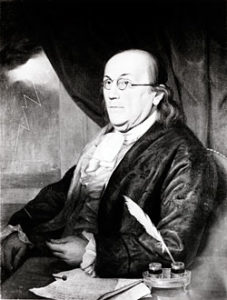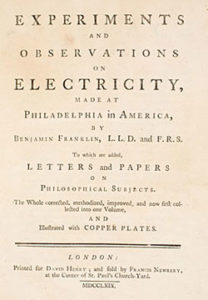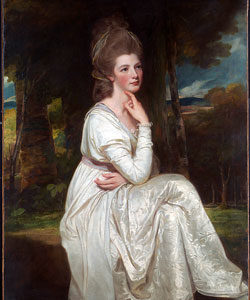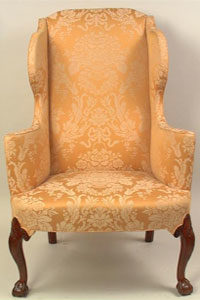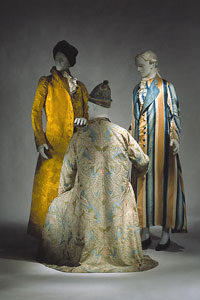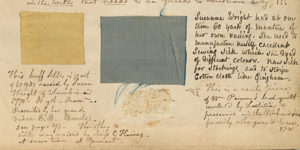Sponsored by the Chipstone Foundation
Benjamin Franklin was nearing death when the American Philosophical Society gathered in Philadelphia to hear the report of a recent local storm. The men listening to this “particular account of the effects of a flash of lightning” must have thought of Franklin as they listened, for their ailing founder was internationally renowned for his experiments with lightning. And indeed it seems their absent leader was on their collective mind. For at that same meeting they voted that “a portrait of Dr. Franklin, the president of the Society, shall, as speedily as is convenient, be executed, in the best manner” and “be perpetually kept” hanging at the American Philosophical Society (fig. 1).
This 1789 portrait was hardly an astonishing commission. There was no shortage of images of Franklin. As he himself once noted, so many paintings, busts, and prints were made of him that his face became “almost as well known as that of the Moon.” This particular portrait, however, stands out within that constellation of images. Commissioned as it was at his advanced age, it gave the artist unusual license to look back and choose to portray Franklin at any stage in his long life. Yet Charles Willson Peale seemingly celebrated the multi-talented, long-lived Franklin for a single achievement, and one he had made decades before: his electrical experiments.
Peale depicts Franklin seated in front of a window in Philadelphia, a red damask curtain behind him. Franklin wears his famous spectacles and a blue damask banyan lined with pink silk. Through the open curtain, we see a thunderstorm raging in the night sky outside as a dramatic, jagged slice of lightning strikes a cluster of brick buildings. Peale shows Franklin posed as he—or anyone with a modicum of common sense—likely never would have sat in a lightning storm, with a lightning rod in his hand and a second one on the table before him. This second rod rests on a paper that includes an excerpt from Franklin’s publication, Experiments and Observations on Electricity, first published in 1769 (fig. 2).
Although it faithfully captures Franklin’s facial likeness, as might be guessed from the practical hazards of holding a lightning rod in the midst of a lightning storm, in its pose and tableau Peale’s portrait is more imagined than copied from life. Indeed, Franklin was too ill to sit more than fifteen minutes for Peale for this portrait. But it is precisely in its imagined symbolism of pose, props, tableau, and dress that this portrait tells us a great deal more than simply what Franklin looked like as an old man.
Commissioned for display within the American Philosophical Society’s newly completed hall by an artist who was also a member of the APS, Franklin’s portrait plays deftly to its intended space and audience. It memorializes the Society’s founder and president as a man of science—the philosophical man who tamed the lightning bolt. The portrait announces more than that, however. What Franklin wears as he writes about American electrical experiments—a silk-lined damask banyan or “gown”—is key to understanding the many meanings that can be teased out from this portrait. Peale’s portrait celebrates Franklin as an intellectual renowned for his electrical experiments, but it is Franklin’s gown that gives us a window into another of his much less well known interests: sericulture, or making silk.
Art historians have discussed the use of banyans in portraits to signify their wearer’s identity as a man of science and intellect. What has not been discussed so much is the importance of the material from which banyans were often made. Franklin’s silk gown, in its material as well as its style and cut, physically embodies connections Franklin and others made between colonial science, revolutionary politics, and sericulture in eighteenth-century America.
A damask banyan is, admittedly, an odd thing in which to find so many layers of American connections. It is a type of clothing that exudes exoticism and cosmopolitanism rather than any obvious Americanness. The very words themselves—”damask” and “banyan”—emphasize this garment’s roots far from North America. Damask was named for the city of Damascus in Syria, while banyans had etymological roots in an Indian term for “merchant.” Both were goods with origins in longstanding European trade looking to Asia and the East. Damasks—fabrics with richly patterned woven designs made of cotton, linen, silk, or wool, usually in stylized floral motifs—entered Europe through trade along the fabled Silk Road. Banyans also first entered European fashion through global commerce, when the Dutch East India Company brought Japanese kimonos into Europe in the 1650s. As actual Japanese kimonos were rarities that were difficult for European consumers to obtain in the market, tailors in places like England soon created their own versions of the garment, a “gown” loosely modeled after kimonos.
Adding to the exotic Eastern flair of the banyan’s origins and cut was that damask silk was often the material from which they were made. Such damask could be pure silk or silk made warmer and more durable by blending it with worsted, or wool. The latter option was particularly popular among London silk manufacturers, for though they never quite mastered growing their own silk, one thing the English did do well was breed sheep. Despite its availability and production in Europe, silk—first made in ancient China, inspired, so the legend goes, by an empress sipping tea under a mulberry tree who saw lustrous possibilities as she watched a silkworm’s cocoon unravel after it dropped from the tree into her cup—was a fabric that retained its ancient association with Asian luxury and exoticism. Such was certainly the case with damask. Part of this Asian connotation stemmed from its name, but even more from its appearance. Visually speaking, damask was one of the most exotic looking of silks. Even after being taken up widely by textile designers and weavers in Italy, France, and England, damask’s visual aesthetic—the pattern it displayed—remained indebted to Asian and Middle Eastern design. Unlike other flowered silks designed and woven in Spitalfields, the heart of the British silk industry, damask was far more likely to feature stylized pomegranates and acanthus leaves reminiscent of Chinese design, for example, than naturalistic English roses (fig. 3).
By the late eighteenth century, both banyans and damask had traveled far from the Silk Road to become widely popular objects around the Atlantic world. Damask was consistently the most popular type of silk colonial Americans imported from London, and although the twenty-first century mind might most readily picture it in the form of a tablecloth, in the eighteenth century it could be found everywhere in a well-to-do British Atlantic world household. Damask served as upholstery for en suite sets of chairs and “sophas,” festooned windows and hung around beds, served as backdrops in portraits, decorated shoes, and covered the bodies of women, men, and children in the form of jackets, dresses, petticoats, waistcoats, and banyans (figs. 4, 5).
Banyans had a similar popularity across the late eighteenth-century Atlantic world. No longer rare and treasured bits of Japanese exotica brought in by the Dutch East India Company, banyans were the ubiquitous uniform of fashionable eighteenth-century men of the British Atlantic world at leisure or in scholarly pursuit at home (fig. 6). Banyans made frequent appearances on the walls of those homes, too, for they were often used in eighteenth-century portraits of men. Their fabric and cut gave clear indications of the sitter’s economic success and gentility. A man wearing a silk banyan was a man with leisure time and refinement enough to have reasons to wear such a gown. Banyans tended to be both long and voluminous. Because of the quantity of high-end fabric required to make them, banyans were expensive, and wearing such a robe in a portrait advertised that this also was a man with money enough to buy such a thing. Banyans also did not change much in their cut or style over decades at a time. For this reason, they functioned almost the same way a classical toga did for a statue—lending the subject a more timeless air through his costume choice than, for example, a more easily (out)dated suit. For all these reasons, artists on both sides of the Atlantic regularly used them in some of the finest men’s portraits we have from the eighteenth century.
The banyan also announced something about the inner mind and character of the man who wore it. A banyan could announce that the man wearing it was a scholar and a natural philosopher. As art historians and the Smithsonian Institution’s National Portrait Gallery exhibition and catalogue, “Franklin and His Friends: Portraying the Man of Science in Eighteenth-Century America” have brilliantly unpacked, banyans were, in short, the international uniform of scientific cosmopolitanism. Many scientifically minded people wore them at home or for their portraits on both sides of the Atlantic. As Dr. Benjamin Rush, another famous Philadelphia man of science, noted, because loose robes “contribute to the easy and vigorous exercise of the faculties of the mind…we find studious men are always painted in gowns.” Artists around the Atlantic world understood and engaged this iconography. Portraits of American men in banyans bear out Rush’s observation. A number of members of the American Philosophical Society—for example, Rush himself, Benjamin Franklin, David Rittenhouse, Cadwalader Colden, Ezra Stiles, and Dr. John Morgan—all had portraits painted wearing such a “gown.”
Peale was very much in keeping with this widespread transatlantic tradition when he painted Franklin as a member of an international “republic of science.” He used Franklin’s scientific treatise and a banyan to announce that his sitter is a cosmopolitan natural philosopher. In 1791, Peale also depicted David Rittenhouse, who succeeded Franklin as president of the APS after Franklin’s death, wearing not just a banyan, but a pink and blue one like that worn by Franklin in his final portrait (fig. 7).
Such visual quotation was deliberate. By painting successive APS presidents in the same costume, Peale combined them in a shared visual narrative. Peale used props and poses to emphasize that both men were American natural philosophers. What links them together most immediately and dramatically for viewers of their portraits is the gown they both wear. Peale used shared costume to connect Rittenhouse, Franklin, and by extension the society they both led, to the recognizable iconography of banyans as cosmopolitan markers of the transatlantic republic of science.
But more than that, these paintings emphasize the local, American identity of these particular natural philosophers. This combination of the local and the cosmopolitan was a matter of pride to the Society that commissioned the portraits. Peale celebrates each man for a scientific experiment conducted in America: Franklin for his electrical experiments with lightning and Rittenhouse for his study of the transit of Venus. He captures each at work on experiments conducted in Philadelphia before the revolution, emphasizing colonial achievements made during a time of imperial crisis. Such colonial, creole knowledge was viewed as evidence of the promise America held as the site of the “westward course” of empire, first as a regenerative site for the British Empire and, later, as its own polity. Peale’s portraits were objects that visually manifested the same belief in American promise that also lay behind the Philosophical Society’s efforts at cultivating American science, agriculture, and husbandry—including their Revolutionary-era efforts at sericulture.
The politics behind the Philosophical Society’s early republican celebration of its thinkers as American intellectuals are clear when one realizes that Peale’s portrait of Franklin cleverly dramatizes a well-known eighteenth-century scientific debate. This dispute among men of science, over whether pointed or blunt lightning rods worked better, escalated into a vicious argument, driven in part by political conflict with the British Empire and eventually involving King George III himself. During the American Revolution, this lightning rod debate captured the public imagination as a metaphor for political change. In the 1760s and 1770s, American Benjamin Franklin and Briton Benjamin Wilson debated the efficacy of the pointed rods Franklin favored versus the blunt rods with a round knob favored by Wilson. Franklin wooed and won most of the Royal Society of London (and by extension the transatlantic republic of science) to his side of the debate. This debate occurred as the American colonies tested British control, however, and with the start of the American Revolution, the dispute turned from a scientific to a political one.
Wilson publicly attacked Franklin’s “use of electrical conductors,” so “greedily adopted in England at the time when Mr. Franklin was an Englishman” and now, since “he was becoming one of the Chiefs of the revolution,” truly “humiliating to British pride.” King George III ordered pointed rods replaced by blunt ones on his palace. Franklin in response further politicized the issue by noting his wish that the king had rejected lightning rods altogether, for “it is only since he thought himself and family safe from the thunder of Heaven, that he dared to use his own thunder in destroying his innocent subjects.” The fact that Franklin was in France, courting French support for the American revolt, when the king approved Wilson’s blunted rods, further intensified the dispute and made it a matter of international gossip. A popular epigram of the time neatly captures the political implications of the lightning rod debate:
While you great George for knowledge hunt
And sharp conductors change for blunt
The Empire’s out of Joint.
Franklin another course pursues
And all your thunder heedless views
By keeping to the point.
Peale—himself, of course, a Patriot—undoubtedly knew of this politically charged international debate over lightning rods, a debate that became a popular epigram for the righteousness of the American revolt against the king. Peale’s portrait brings to mind politics as well as science, for its inclusion of both a pointed and a rounded rod is a nod to revolutionary politics and disagreement with the king.
Like the lightning rod, American sericulture came to express both revolutionary political as well as scientific and economic meaning. It is less obvious to the viewer, but silk’s scientific and political significance is also portrayed in Franklin’s portrait. Silk was of practical as well as aesthetic value to eighteenth-century natural philosophers. Men of science like Franklin didn’t just wear silk; they used it. Silk, believed to be “extremely susceptible to electricity,” was commonly used in scientific experiments. In the experiment memorialized both in Peale’s painting and the above epigram, for example, Franklin described making the body of a kite from a “Large Thin Silk Handkerchief” and fastening a key onto a silk ribbon at the end of the kite’s twine tail. On the other side of the Atlantic around the same time, Robert Symer read a series of extensive papers on the electrical properties of silk stockings to London’s Royal Society. Such handkerchiefs, affordable bits of silk luxury, were widely available in late eighteenth-century America. Handkerchiefs had a wide market (descriptions of runaway slaves and servants mention their possessing them). Perhaps because of their availability to a wide range of consumers, they could generate great wealth for their makers. Lewis Chauvet, for example, made huge sums from his London manufactory of Spitalfields silk handkerchiefs, which employed 450 workers in the late 1760s. Chauvet had the reputation of paying silk weavers wages that were below the going rates despite the fact that he had the financial means to provide adequate remuneration. In protest, impoverished London weavers destroyed some of Chauvet’s silk by cutting it off the manufactory’s looms—and ended up hanged for their trouble.
In Revolutionary-era America, Franklin and his fellow APS members linked politics as well as science to the production of silk. The shared banyan in Peale’s portraits of Rittenhouse and Franklin clearly announced their common identity as men of science. But it also celebrated their shared identities as revolutionaries. Objects like portraits and silk tied these men together, material reminders of the intellectual connections they shared as colonial men of science as well as members of the transatlantic republics of science or letters. Many of the APS members who had their portraits painted wearing banyans had serious interest in sericulture as well. In the 1760s, the same decade Franklin published his Experiments and Observations on Electricity, learned members of the APS began to pursue sericulture in earnest. This project encapsulated how their fascination with silk went beyond mere scientific and economic interests to touch upon themes of pride in American progress that, in the next decade, some of them (though not all) would use to make a revolutionary political statement.
In the mid-1760s, apothecary Moses Bartram, APS member and son of the internationally famed Philadelphia botanist John Bartram, decided to experiment with worms he found on the banks of the Schuylkill River. Like any good natural philosopher, Bartram subjected his worms to a series of detailed empirical observations, carefully assessing their viability as silk producers. After a few abortive first attempts, Bartram became convinced that the local silkworms might produce silk as good as that from Italy, or even China. Excited by the economic possibilities, Bartram was among those who spearheaded the establishment of a Society for Promoting the Cultivation of Silk, or the “Silk Society,” by the American Philosophical Society in 1770. The Silk Society was under the umbrella of the APS “Committee on Husbandry and American Improvements,” and it aimed to make sericulture a proud colonial accomplishment in both husbandry and manufacturing. The Silk Society concocted a grandiose plan for a widespread project to encourage Pennsylvanians to plant mulberry trees for feeding silkworms, to raise silkworms from egg to worm, harvest the worms’ cocoons for raw silk, and wind that silk into loosely coiled yarn, or skeins, for overseas shipment in a specially built Philadelphia workplace for winding silk, or a filature. Bartram’s worms were most likely among the worms the Silk Society gave out to encourage the success of their project.
The Silk Society chronicled its plans and put out its call for participants and funders in a book they also published—rather hastily—in 1770. This book, the subject of a “Notes on the Text” published last year in Common-place, was the ponderously named Directions for the Breeding and Management of Silk-Worms. Extracted from the Treatises of The Abbé Boissier de Sauvages, and Pullein. with a Preface giving some Account of the Rise and Progress of the Scheme For encouraging the Culture of Silk, in Pennsylvania, and the Adjacent Colonies. When the book was published, it included excerpts of letters and advice Franklin sent from London. Franklin called silk “the happiest of all inventions for cloathing” and was keen to see America—Pennsylvania in particular—become the leading supplier of the raw silk that London’s silk weavers made into the damasks and brocades they shipped back across the Atlantic to the North American colonies.
Encouraging the Silk Society’s efforts at Pennsylvania sericulture was among the activities in which Franklin engaged while in London. As he was promoting his work on electricity, he was also at work promoting American silk. In addition to writing letters of advice and sending copies of both French publications and Chinese prints on silk-making back home to Philadelphia, he hosted Spitalfields silk industry experts at his London residence to seek advice on improving the silk. He arranged for skeins of American silk to be woven into textile lengths in Spitalfields, and sold the silk and gave it to influential political contacts like members of the proprietary Penn and regal Hanover families. Dr. John Fothergill, the British Quaker physician with a fascination for plants who wrote the preface to Franklin’s Experiments and Observations on Electricity, helped him in this work. The two friends delighted in the conversations they had about sericulture, its history, and its future.
Such conversations were neither limited to the erudite members of the republic of science nor to men, however. In fact, at least some of the silk Franklin and Fothergill unpacked and discussed was produced by one of Franklin’s circle who, although also highly educated and intellectual, was neither a member of the Philosophical Society nor a man: Susanna Wright. Although the managers of the Silk Society (like the members of the American Philosophical Society) were all men, women played a prominent role in Pennsylvania—and American—sericulture. Wright was one of those eighteenth-century women who was near, but not quite of, the republics of science and letters. “The famous Suzey Wright,” as Benjamin Rush called her, was celebrated for “her wit, good sense & valuable improvements of mind.” A widely read correspondent of American intellectuals like James Logan, Wright also engaged in the same scientific experiments on sericulture that men did. Like Moses Bartram, she raised local worms and recorded observations about them in a publication. And she had the distinction of winning the 1771 contest for silk production advertised in the Silk Society’s 1770 book (fig. 8).
Wright was an exceptional woman, but she was not unique. Franklin’s daughter, Sally Franklin Bache, also took an interest in homespun silk—and a pointedly political one at that. Once the American Revolution started, Benjamin Franklin continued to serve as the APS agent for its Silk Society, but he did so in France rather than in England. With the Revolution commenced, Americans were still eager to prove that they could produce silk, but they were now eager to do so on behalf of their own fledgling nation, rather than to enrich the British Empire. Bache wrote to her father in France, asking him to send her some lace, feathers, and, as she put it, “other little Wants,” to wear to the convivial events being held to celebrate the end of British occupation in Philadelphia. Her father curtly admonished her to cease asking him for such fripperies and instead to concentrate on her spinning. A woman’s place in Revolutionary politics, it seemed, was to make homespun. Bache’s dutiful, if somewhat hurt response, was to ask “how could my dear Papa give me so severe a reprimand for wishing for a little finery” and to send her father a clever reply to his admonishment that she spin rather than seek luxurious finery. Her rejoinder was a material one: evidence of homespun—but luxurious homespun—in the form of a gift of twenty-two yards of Pennsylvania silk for Queen Marie Antoinette.
The choice of Franklin’s daughter to prove her patriotic industry by sending her father not serviceable homespun, but rather homespun silk, highlights the political possibilities American silk embodied during the Revolution. When viewed in historical context, Bache’s gift for Marie Antoinette, contrary to her father’s dismissive comments, made a great deal of cultural and political sense. As Franklin knew better than most anyone, Bache was hardly the first to offer American silk to a European queen. In 1771, Benjamin Franklin sorted out the best piece of the Silk Society’s samples of Wright’s Pennsylvania silk for George III’s queen, Charlotte, who planned to wear it for the celebration of the king’s birthday. Bache knew, just as well as the members of the American Philosophical Society, the political symbolism of her transatlantic gift of American silk. Bache’s gift was part of a historical pattern of symbolic gift-giving. By replicating the Philosophical Society’s act of presenting silk to a queen, but offering it to the French—rather than the British—queen, Bache made it clear that American allegiance had shifted away from the English crown. Her gesture illustrated something else, however. Bache’s gift to Marie Antoinette showed how women as well as men could use silk for political purposes, just as Susannah Wright and others proved that women as well as men could raise silkworms and excel at the labor of making silk.
The story told about Peale’s portrait of Franklin wearing a banyan usually focuses on its meanings as a marker of scientific cosmopolitanism and celebration of colonial science, revolutionary American politics, and pride in the APS. Certainly, it is all these things. But it is also more. Franklin’s gown also invites us to delve into the history of Franklin’s involvement in sericulture—one of this American Renaissance man’s interests not often discussed. Tracing the associated meanings of Franklin’s gown outside the portrait reminds us of something we would never know were we only to consider Franklin’s gown within the context of portraits of men wearing banyans: that women as well as men participated in global networks of scientific cosmopolitanism and sericulture pursuits, just as women as well as men wore silk. Their stories are harder to uncover, and far less often displayed. But taken together, both Franklins’ gowns—the one worn by the father in his Peale portrait, and the one given by the daughter to Marie Antoinette—tell a narrative about the gendered politics of American sericulture, transatlantic scientific networks, and the American Revolution.
Further Reading
On portraits of scientifically minded men wearing banyans, the definitive work is Brandon Brame Fortune, with Deborah J. Warner, Franklin and His Friends: Portraying the Man of Science in Eighteenth-Century America (Philadelphia, 1999). Women as well as men sometimes wore matching clothing in portraits. For one of the best discussions of this phenomenon, see Margaretta M. Lovell, “Copley and the Case of the Blue Dress,” The Yale Journal of Criticism 11:1 (Spring 1998): 53-67. For detailed discussion of the Spitalfields silk trade, see Natalie Rothstein’s beautifully illustrated Silk Designs of the Eighteenth Century: In the Collection of the Victoria and Albert Museum, London, With a Complete Catalogue (London, 1990). To date, the best work on colonial sericulture efforts focuses on the South. See work by Ben Marsh such as “Silk Hopes in Colonial South Carolina” in The Journal of Southern History 78:4 (November 2012). Marsh’s forthcoming book, Unraveling Dreams: Silkworms and the Atlantic world, c. 1500-1840 also promises to add a great deal to colonial sericulture history. Also see the introductory section of Jacqueline Field, Marjorie Senechal, and Madelyn Shaw, American Silk, 1830-1930: Entrepreneurs and Artifacts (Lubbock, Texas, 2007). For work that considers colonial sericulture within the larger context of American husbandry projects and Enlightenment thought on progress, see Joyce Chaplin, An Anxious Pursuit: Agricultural Innovation and Modernity in the Lower South, 1730-1815 (Chapel Hill, N.C., 1993). For what is perhaps the best look at how colonists (men and women both) contributed to Atlantic world natural history networks, see Susan Scott Parrish, American Curiosity: Cultures of Natural History in the Colonial British Atlantic World (Chapel Hill, N.C., 2006). To read more correspondence between Franklin and sericulturists in Philadelphia, and between Franklin and his daughter, see Franklin’s papers online.
This article originally appeared in issue 15.1 (Fall, 2014).
Zara Anishanslin is assistant professor of history at the College of Staten Island/City University of New York. In 2014-15 she is also a Mellon Postdoctoral Fellow at the New-York Historical Society. Her first book, a history of the eighteenth-century British Atlantic world told through the single portrait of a colonial woman in a silk dress, is forthcoming from Yale University Press.



